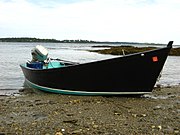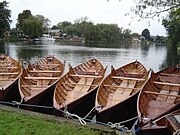Difference between revisions of "AY Honors/Rowing/Answer Key"
m (82 revision(s) from w:Skiff) |
m (Transwiki:Skiff moved to AY Honor Rowing: transwiki merge) |
(No difference)
| |
Revision as of 02:03, 15 November 2007
The term skiff is used, and has been used, to refer to many various types of seemingly unrelated small boats. The word has a complicated etymology: it comes from the Middle English skif, which derives from the Old French esquif, which in turn derives from the Old Italian schifo, which is itself of Germanic origin. The word is related to ship.
One current usage of skiff is to refer to a typically small flat-bottomed open boat with a pointed bow and a flat stern originally developed as an inexpensive and easy to build boat for use by inshore fishermen. Originally designed to be powered by rowing, their form has evolved so that they are efficiently powered by outboard motors. The design is still in common use today for both work and pleasure craft.
The Thames skiff is a round-bottom clinker-built boat that is still very common on the River Thames and other rivers in England and featured in the famous book about a journey up the Thames, Three Men in a Boat. During the year, skiffing regattas are held in various river-side towns - the major event being the Skiff Championships at Henley.
Another current usage of skiff is to refer to a type of high performance sailing dinghy, one that usually features an asymmetrical spinnaker and requires that the crew use a trapeze to help balance the boat. Examples include: 12ft Skiff, 16ft Skiff, 18ft Skiff, 29er, 49er, Musto Skiff, and International 14.
The Panga
The Central American/Mexican version of a skiff is generally called a 'Panga'. The term "Panga" was used historically for any small boat other than dugout canoes. Today it usually refers to an open "semi-dory" type skiff.
Pangas form the backbone of the small-scale fishing effort in Mexico, Central America and much of the Caribbean.
Pangas are usually between 19 and 28 feet in length, with capacities ranging from 1 to 5 tons and powered by outboard motors of between 45hp and 200hp. They are planing hulls capable of speeds in excess of 35 knots.
The hulls are made of Fiberglass or FRP, heavily reinforced by numerous bulkheads and usually have bow and stern enclosed flotation compartments.
In the hands of an experienced operator they are considered extremely seaworthy. Most pangas are expected to have a working life of between 5 to 10 years if properly maintained.


